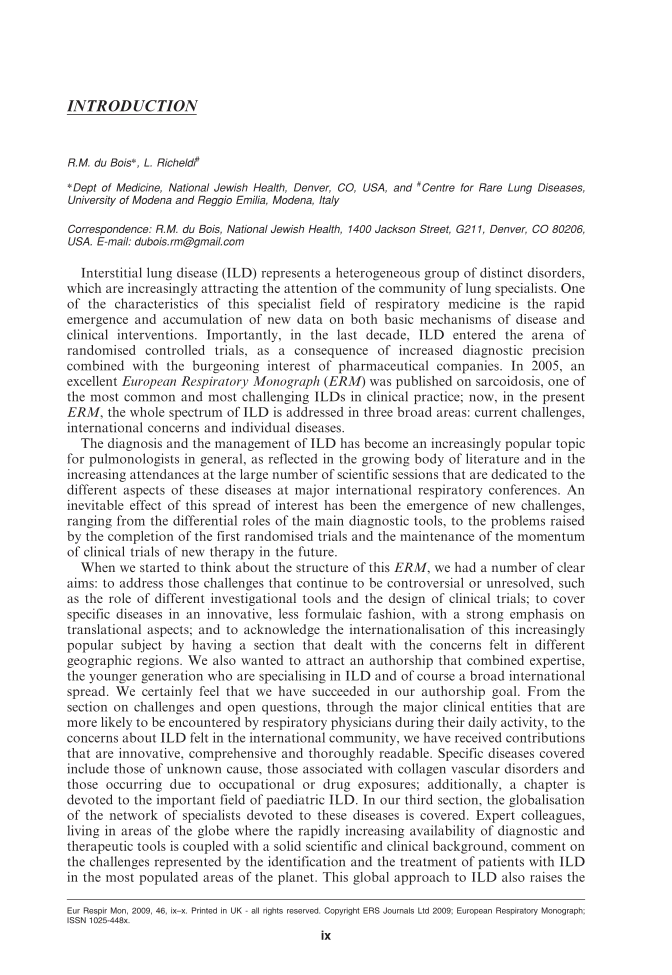INTRODUCTION R.M. du Bois*, L. Richeldi # *Dept of Medicine, National Jewish Health, Denver, CO, USA, and # Centre for Rare Lung Diseases, University of Modena and Reggio Emilia, Modena, Italy Correspondence: R.M. du Bois, National Jewish Health, 1400 Jackson Street, G211, Denver, CO 80206, USA. E-mail: dubois.rm@gmail.com Interstitial lung disease (ILD) represents a heterogeneous group of distinct disorders, which are increasingly attracting the attention of the community of lung specialists. One of the characteristics of this specialist field of respiratory medicine is the rapid emergence and accumulation of new data on both basic mechanisms of disease and clinical interventions. Importantly, in the last decade, ILD entered the arena of randomised controlled trials, as a consequence of increased diagnostic precision combined with the burgeoning interest of pharmaceutical companies. In 2005, an excellent European Respiratory Monograph (ERM) was published on sarcoidosis, one of the most common and most challenging ILDs in clinical practice now, in the present ERM, the whole spectrum of ILD is addressed in three broad areas: current challenges, international concerns and individual diseases. The diagnosis and the management of ILD has become an increasingly popular topic for pulmonologists in general, as reflected in the growing body of literature and in the increasing attendances at the large number of scientific sessions that are dedicated to the different aspects of these diseases at major international respiratory conferences. An inevitable effect of this spread of interest has been the emergence of new challenges, ranging from the differential roles of the main diagnostic tools, to the problems raised by the completion of the first randomised trials and the maintenance of the momentum of clinical trials of new therapy in the future. When we started to think about the structure of this ERM, we had a number of clear aims: to address those challenges that continue to be controversial or unresolved, such as the role of different investigational tools and the design of clinical trials to cover specific diseases in an innovative, less formulaic fashion, with a strong emphasis on translational aspects and to acknowledge the internationalisation of this increasingly popular subject by having a section that dealt with the concerns felt in different geographic regions. We also wanted to attract an authorship that combined expertise, the younger generation who are specialising in ILD and of course a broad international spread. We certainly feel that we have succeeded in our authorship goal. From the section on challenges and open questions, through the major clinical entities that are more likely to be encountered by respiratory physicians during their daily activity, to the concerns about ILD felt in the international community, we have received contributions that are innovative, comprehensive and thoroughly readable. Specific diseases covered include those of unknown cause, those associated with collagen vascular disorders and those occurring due to occupational or drug exposures additionally, a chapter is devoted to the important field of paediatric ILD. In our third section, the globalisation of the network of specialists devoted to these diseases is covered. Expert colleagues, living in areas of the globe where the rapidly increasing availability of diagnostic and therapeutic tools is coupled with a solid scientific and clinical background, comment on the challenges represented by the identification and the treatment of patients with ILD in the most populated areas of the planet. This global approach to ILD also raises the Eur Respir Mon, 2009, 46, ix–x. Printed in UK - all rights reserved. Copyright ERS Journals Ltd 2009 European Respiratory Monograph ISSN 1025-448x. ix
